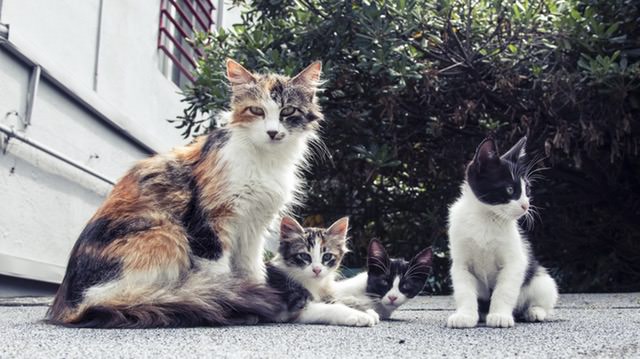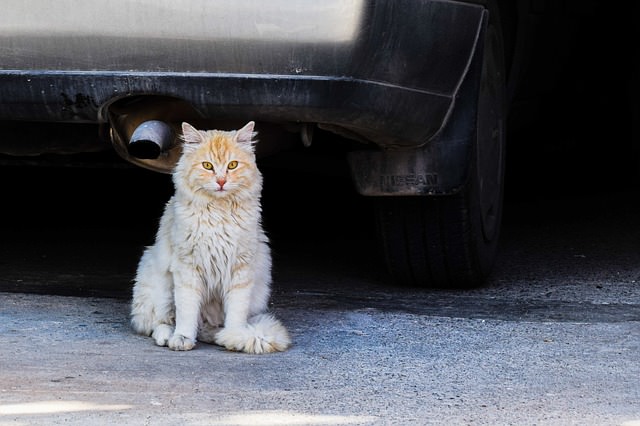Most people are used to stray cats. They’re usually fairly friendly, they might come over to greet their human neighbors, and they have generally happy lives being fed by the citizens of the community. Stray cats sometimes start as pets that get away, were abandoned, or as kittens born as strays who grew up being fed by local people. They might be a little shy, but they’re used to interacting with people and being around them.
Feral cats, however, are a different story. Feral cats have lived their entire lives away from humans. Like raccoons or opossums, they are wild animals living at a distance from humans. They have never interacted with humans, as they have no desire to, and often catch their own food or eat scraps they find at times when no humans are around. Feral cats will hide from humans at all costs and become very defensive and aggressive when captured or approached.

Many believe that the lives of feral cats are sad and dangerous, but this is not always the case. Yes, living in the wild does pose a more natural circle of life and these cats generally do not live as long as their domestic counterparts. That said, they are generally very happy in their natural, human-free world. Although feral kittens can and have been successfully rehabilitated to become pets, most adult feral cats will never truly be domesticated. This is because the kittens have lived just a few months alone, whereas adult cats have spent years without human interaction.
How Can I Help Feral Cats In My Area?
Trap, Neuter, Return
There are things you can do to make feral cats a little safer and more comfortable. Keep in mind that they often will not approach humans and should not be handled, as this could be potentially dangerous for both you and the cat. Still, some human intervention can help these wild cats.
Perhaps the most important piece of human interaction is the ability to trap, neuter and release these feral cats. Working with your local animal shelters and humane societies, volunteers for TNR programs are much appreciated. Trapping feral cats, spaying and neutering them and then releasing them to their natural homes away from people has shown to significantly decrease the feral cat populations all over the world. This also improves the quality of life for stray and pet cats, as there are fewer chances of contracting illnesses from the feral animals. Most cats that have been spayed or neutered will have a notch in their ear.

Begin A Feeding Schedule
Feral cats also appreciate a regular source of food. Although you shouldn’t just leave food out constantly, setting up a schedule will help the cats feel a little more comfortable around humans. Don’t expect the feral cats to come near you and eat, they’ll likely wait for you to leave since you’re rather threatening in their eyes. Keep the food out for 45 minutes to an hour, because any longer will actually entice other wildlife – like insects, raccoons and even coyotes – into your neighborhood. Work with your neighbors on where to feed these cats as well, since many might not be as excited as you to have cats around their home.
Offer Shelter Away From People
Building shelters is also a nice gesture towards feral cats. There are hundreds of easy, DIY cat-house projects to follow on the internet. Simple shelters are very easy to make, and if you’re extra crafty, providing an insulated shelter will help during extreme temperatures.
This doesn’t mean you have to take these cats into your home. Shelters can be left in places where the feral cats regularly roam, so long as your neighbors don’t consider it an eyesore. Furthermore, you might find that these shelters are often used as nesting areas for female cats with kittens. Taking these kittens in and rehabilitating them once they are ready to leave their mother will increase their chances of finding a loving home as a domesticated pet. If possible, try and catch mom too so she can be spayed and returned to her natural life.

Feral cats are interesting creatures, benefiting from limited human intervention and preferring to live without the presence of people. With successful TNR projects and minimal care such as food and shelter from people, feral cats can and do live long, happy lives. Their lives might not look ideal to us, but they are often happier outside than being fostered in a home with strangers. If you’re interested in working with feral cats, talk to your local rescue organizations, shelters, and humane societies on how to become more involved in a way that’s safe for both you and the cats.

